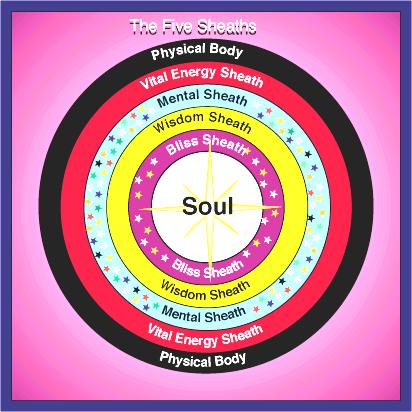2. Brahmananda Valli:
The preceding chapter presented the knowledge of Atman conditioned by upadhis and also meditation associated with rituals. But neither of these can destroy ignorance which cane be destroyed only by the light or Knowledge of Brahman as discussed in the nine sections of this second chapter of the Upansihad.
The 1st section speaks of Brahman as satyam (Reality), jnanam (Knowledge) and anantam (Infinity). Although Brahman is a man’s inmost self, he is not conscious of it because the Self is hidden by various sheaths (kosha) like a sword. These sheaths created by ignorance are five in number as shown in the diagram below.

They are 1. annamaya kosha – food or matter, 2. pranamaya kosha – vital breath, 3. manomaya kosha – mind, 4. vijnanamaya kosha – intellect or wisdom and 5. ananda maya kosha – bliss and they are arranged in the telescopic manner, one inside the other, the outer deriving its vitality from the inner.
* The first section describes the outermost sheath which is gross physical sheath produced from food we eat (annam).
* The second section describes the next sheath called the vital breath (prana) which pervades the physical sheath.
* The third section describes that of the mind (manas).
* The fourth section describes the sheath of the intellect (vijnanam)
* The fifth section deals with that of the bliss (anandam). The Upanishad speaks of the sheaths which constitute the gross, subtle and causal bodies of a living creature. Brahman is the innermost reality which is untouched by any of them. The five sheaths, though not Brahman, are described as such in a figurative sense so that the ordinary mind may be trained, step by step, to contemplate subtle truths.
* The sixth section asserts that Brahman is real because the phenomenal universe consisting of entities either endowed with form or without form cannot exist in the absence of a support or cause. The same Brahman dwells in the hearts of all as Consciousness and manifests Itself in all acts of cognition.
* The seventh section describes Brahman as self-made which means that It is the material and efficient cause of the universe. It is the causeless cause or independent cause, being the cause of everything, but is Itself without a cause. Brahman is the essence of all things, the controller of vital breath, the non-dual support of the universe, and the source of fearlessness.
* The eighth section describes the bliss of Brahman of which the worldly happiness is a mere reflection. Even the highest worldly happiness is produced by external factors and depends upon certain actions on the part of the enjoyer, from Brahma down to man. Beyond the highest worldly happiness lies the Bliss of Brahman, experienced by those who have realized their identity with the Supreme Spirit. The Bliss of Brahman does not admit of higher or lower degrees.
* The ninth section reiterates that the knower of Brahman attains fearlessness. He is not tormented by the illusion of good and evil which is produced by ignorance. When ignorance is destroyed, both good and evil, like all other phenomenal categories, merge in Brahman. Thus the illumined person removes good and evil of their phenomenal nature and realizes them as Brahman only.
3. Bhrigu Valli
This chapter is a dialogue between Varuna and his son Bhrigu which teaches the Knowledge of Brahman.
* The first section defines Brahman as the cause of the creation, continuance and dissolution of the universe. It describes the body and sense-organs as channels for the Knowledge of Brahman. Varuna leads Bhrigu step by step to the realization of Brahman in the following sections.
* The second to sixth sections describe Brahman as the physical universe, as the prana, the mind, the intellect and finally as Bliss. Bhrigu ultimately discovered that Brahman alone is real and everything else is merely superimposed on it.
* Sections seven to nine describe the importance of food.
* The tenth chapter teaches various forms through which one can meditate on Brahman.
With the above Introduction in the back-drop, we shall take up the study of the Taittiriya Upanishad Text from next time.
HARIH OM